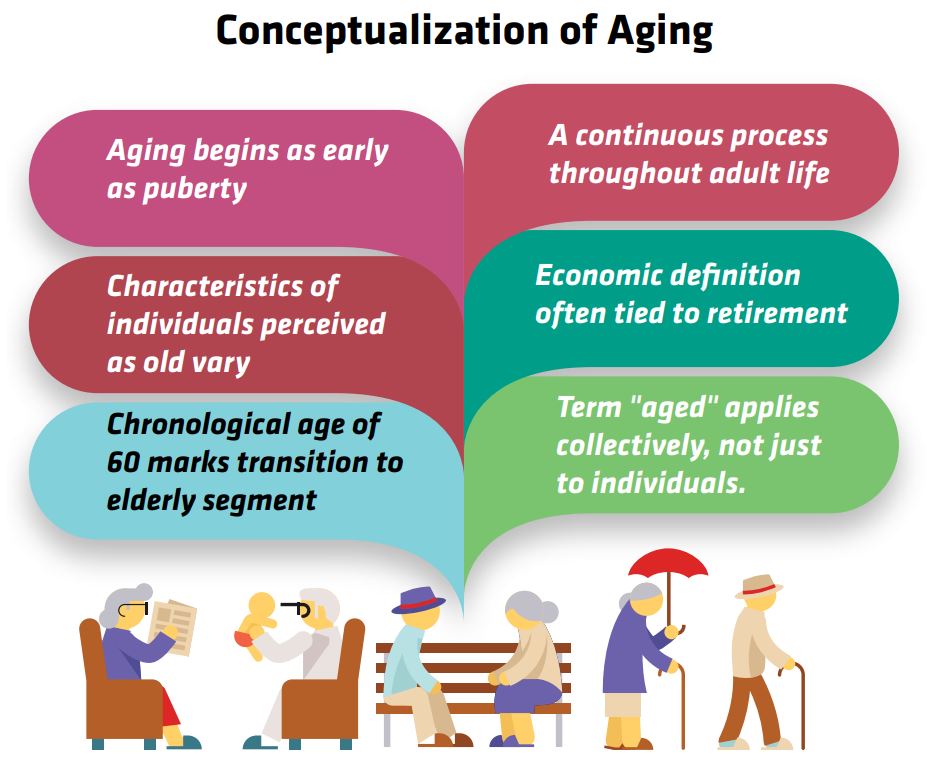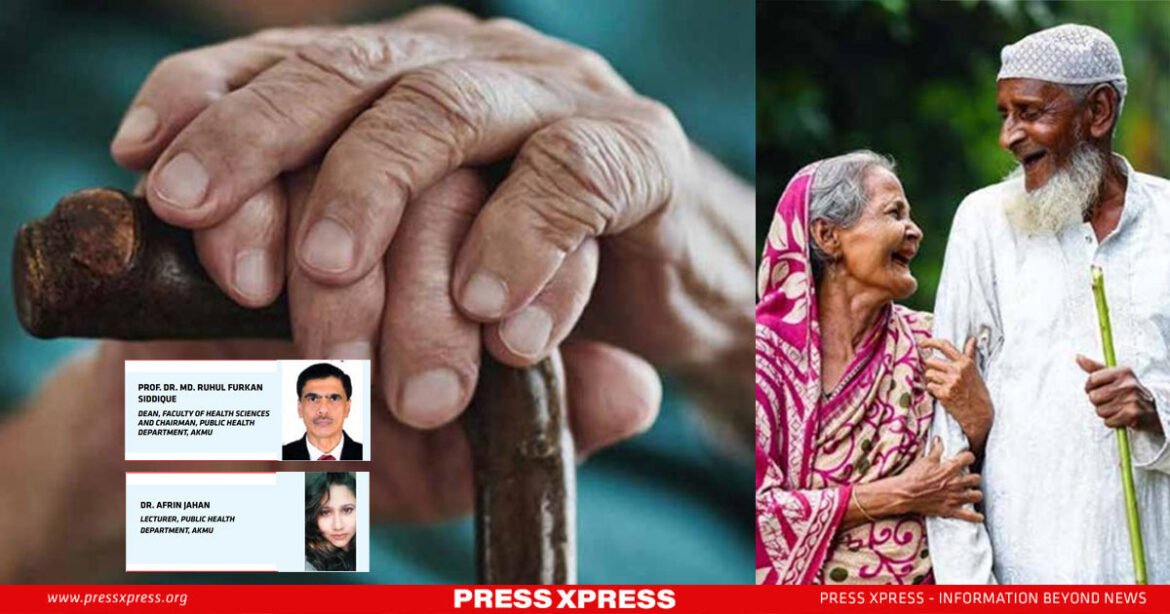Aging is a universal degenerative process for all organic beings which leads to death. Though it is a biological process and depends on genetic factors yet economic, social, and political processes including the cultural construction of aging, significantly influence it in the case of Human beings. Awareness about national and international greying and its problem and potential are very much essential in Bangladesh where the life expectancy at birth is 72 years and rapidly increasing. It was only 24 years in 1901. About 8% of the total population (SVRs: Sample Vital Registration System 2017) are senior citizens in Bangladesh.
You can also read: Future of Petrodollar Vs National Currency



Aging population of Bangladesh from 1971 to 2023 and its comparison with the population structure of Europe Our agrarian society is rapidly moving towards an industrial one. Chaotic urbanization, breaking down joint and extended families into nuclear ones, population migration, and gender and cultural construction of aging are to be considered during any policy or strategy formulation for this segment of the population- the senior citizens. Gerontology is the scholarly and practice-oriented discipline concerned with the latter segment of the life course and is unique in that it is truly multidisciplinary. In Gerontology aging is viewed in terms of four processes.
These are:
1. Chronological aging:
It is the definition of aging on the basis of a person’s year from birth.
2. Biological aging:
It is the inertia of a complex biological system where the intelligent faculties increase both in quality and quantity at the expense of the physical changes, the reduction of the efficiency of the organ system.
3. Psychological aging:
It includes the changes that occur in sensory and perceptual processes, mental functioning, personality, drives, and motives.
4. Social aging:
Refers to an individual changing roles and relationships of the aged in the social structure.
CONCEPTUALIZATION OF AGED
The WHO Expert Committee on the Health of the elderly has extended its concern about the problem of the definition of elderly. The committee however, had viewed that biologically it begins at least as early as puberty and is a continuous process throughout adult life, while socially the characteristics of members of the society who are perceived as being old, economically it is defined in terms of retirement or chronologically 60 years is defined as the age of transition of people to the elderly segment of the population. WHO experts further thought that this Criterion may vary from culture to culture and from generation to generation.
The term ‘aged’ not only describes individuals but also is used as a collective noun. Once one is identified as old, he is perceived exclusively as such. The wife of an old man is always considered old without considering her age and age at marriage (It is much less than male partners, especially in developing countries-early marriage). Even the alternative terms sometimes used to soften the negative connotation of the word “old”, the elderly, older persons, senior citizens, old age pensioners – all stigmatize the aged.

SITUATION ANALYSIS
According to an Ethnographic study (anthropological study) in 2001 conducted on 66 elderly residents of the village Ichhali of Gazipur District, showed that the term “aged” is culturally constructed and denotes people who are unable to support themselves, cannot work, and are physically unfit. Food and clothes are being considered to be as essence of life. A significant number of aging inhabitants are marginalized and lonely.
Overwhelming majority lead an active life, do household work and engage in activities related to cultivation and so could be considered as invisible work force. They perceive that old age is associated with diseases and so they do not pay adequate attention to illness. Physical examinations of 60 key informants particularly tracing ECG, measuring blood pressure, analyzing urine for sugar, taking height and weight, assessing personal cleanliness show that a significant number are suffering from various abnormalities, commonly with several active diagnosable diseases. Absolute majority lack economic and social suport from the state or society.
Insignificant assistance that are provided to them by the sons is gradually decreasing. Where the role of daughter-in-law is considered to be prominent. Imbalances created due to lack of financial security and social support contribute to the poor status of health of the aged.
At present, Bangladesh Govt. has set up a wide range of social security programs that have strong coverage for the protection and care of the older population, including a pension system, retirement benefits, and other initiatives under the National Social Security Strategy (NSSS) like the Old Age Allowance, Allowance for Freedom Fighters, Allowance for Widow and Husband Deserted Women, and Vulnerable Groups’ Feeding (VGF).

CONCLUSION AND RECOMMENDATION
It is clear that the situation changed, and has been changing and yet demands attention for future action. Senior citizens vulnerability in Bangladesh is influenced by medical, financial, emotional, and social challenges, impacting not only individuals but also the community. Rising medical expenses, strain on social security, and unemployment are major issues faced by the elderly population. The following recommendations are noteworthy for working towards mainstreaming the aging population in Bangladesh:
Further research is recommended to understand the current situation following the implementation of positive government initiatives, particularly as life expectancy at birth continues to be increased.
Targeted health initiatives-geriatric care for the elderly population should be created, like those of the children and women to provide all-encompassing care and assistance.
Free registration system and a separate queue for the aged population (determined by National ID) in Govt and non-govt hospitals.
It would be beneficial for the nation to create jobs targeted to the skills of the elderly people, such as part-time employment in previous workstations, small businesses or poultry farms, and agricultural sectors etc.
The recognition of the contributions of the invisible workforce (skilled work in the family of the aged people, kitchen works of women) in the household and agricultural sectors should be visualized through media.
Prioritizing integration or rehabilitation initiatives, especially for widows and widowers, might involve reconnecting with their family members through family counseling sessions, mediation services, or family reunion programs. Furthermore, establishing supportive environments that promote open communication and empathy among family members might help in resolving conflicts and strengthening bonds.

In conclusion, to properly handle the requirements of the aging population, it is necessary to acknowledge the elderly people as a unique group that requires the attention of the entire country, not just one ministry. By recognizing and addressing the multidimensional nature of aging, policymakers, and stakeholders can work towards mainstreaming the elderly population in Bangladesh, ensuring their well-being and dignity in the later stages of life. These wise, experienced, and knowledgeable individuals are the country’s greatest asset and have an obligation to be looked after.


